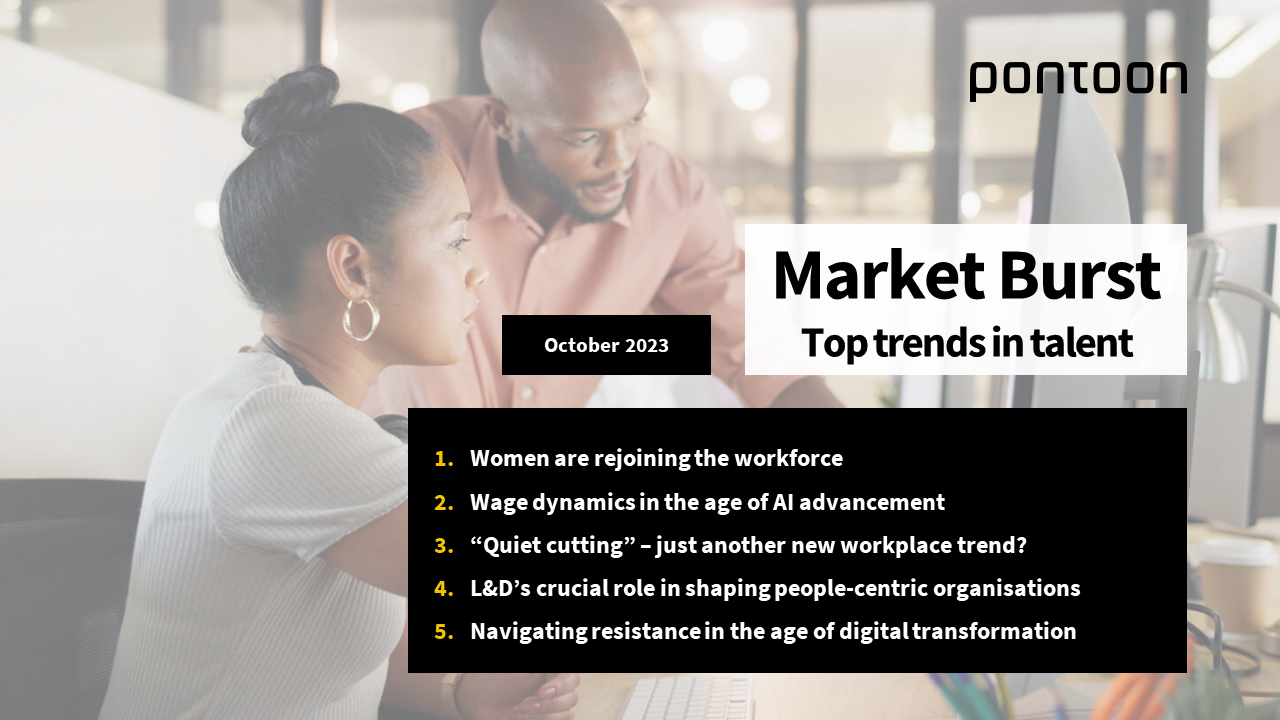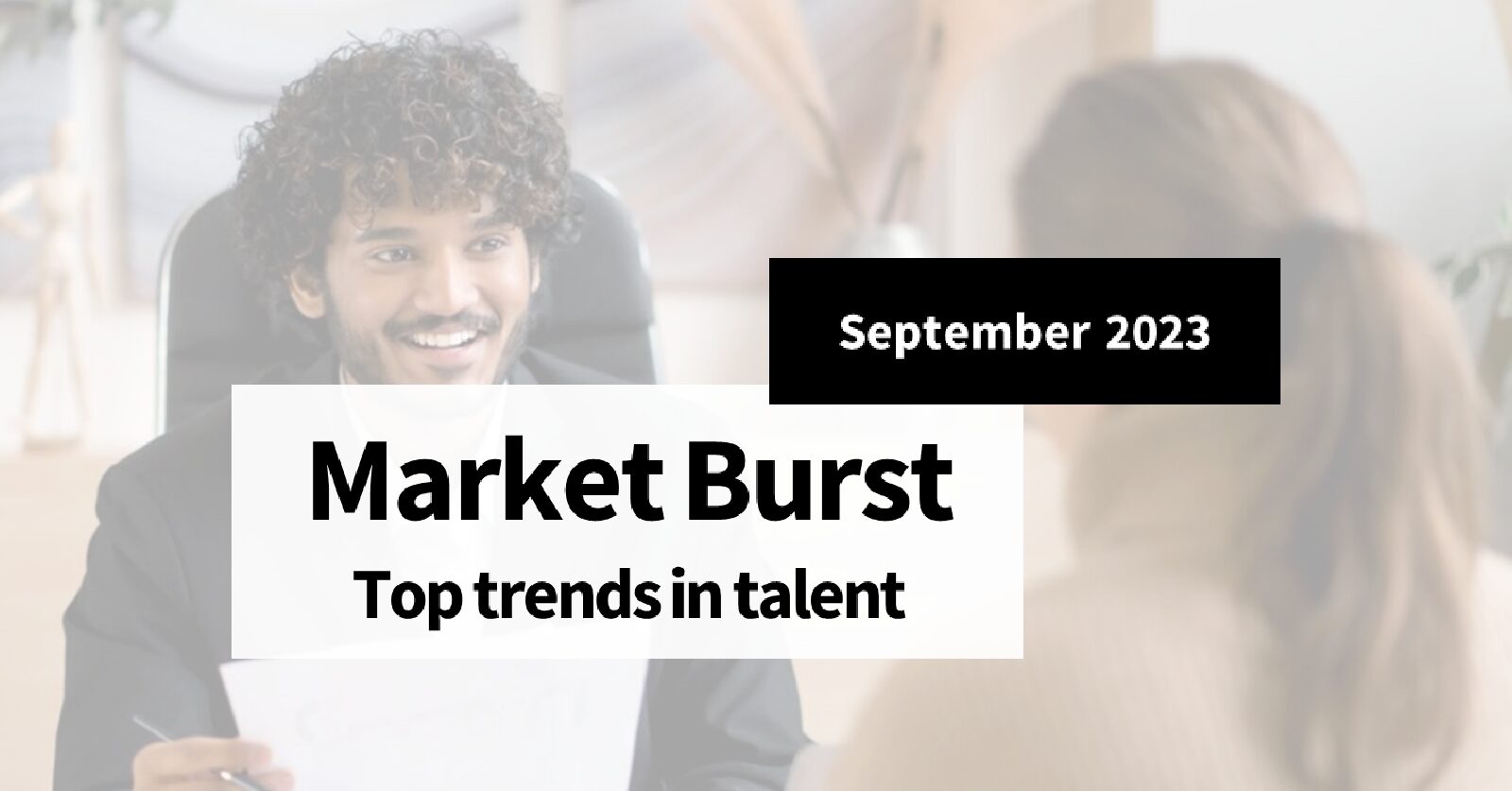Market Burst: October 2023
Read about top trends in the world of work.
In this month’s instalment of our Market Burst, we dive into the trends that continue to drive talent management in the evolving workspace. These include wage dynamics in the age of AI, quiet cutting, L&D’s crucial role in shaping people-centric organisations, and more.
Women are rejoining the workforce
Women are returning to work in record numbers. According to the Bureau of Labor Statistics (BLS), as of June 2023, an unprecedented number of women, particularly those aged 25 to 54, have re-entered the workforce. This return marks the highest participation rate since the onset of the COVID-19 pandemic. Furthermore, recent data reveals that the labour force now includes more mothers than ever, surpassing pre-pandemic levels.
Yet, this seemingly positive news carries a complex undercurrent that demands closer examination. For instance, July 2023 data from the BLS indicates that the gender wage gap persists, though at its narrowest since 1979. On average, women in the US earn only 83% of what their male counterparts do. This disparity is even more pronounced for Black, Hispanic, and Indigenous women and those aged 35 and older. Given these dynamics, employers must continue to take proactive steps to attract and retain more women in their organisations. Some strategies to consider include:
- Flexible work arrangements. The rise of remote and hybrid work models has been a lifeline for many women, enabling them to balance professional and personal responsibilities more effectively. Maintaining such arrangements is crucial for retaining women in the workforce.
- Promote pay parity. Organisations must strive to close the wage gap. This involves conducting regular pay audits, adjusting wages where necessary, and ensuring transparency around pay scales.
- Support work-life balance. Employers must recognise and address the dual burden of paid work and unpaid domestic responsibilities that many women face. This can be achieved through supportive policies such as childcare assistance, flexible scheduling, and mental health resources.
- Encourage inclusive leadership. Leaders should cultivate a culture that values and respects diversity. This includes equal opportunities for advancement, mentorship programmes, and unconscious bias training.
While the return of the female workforce is a positive development, their journey is far from over. Employers are pivotal in removing systemic barriers and creating workplaces where women can thrive.
Wage dynamics in the age of AI advancement
Everyone’s still talking about how AI will revolutionise our work, but it’s also crucial to start thinking about how it may impact pay.
More robust studies are yet to be developed; however, some already available sources suggest that companies will likely need to compensate star performers for their high-quality inputs to AI tools that enhance the work of less experienced and skilled colleagues. While certain executives may decide that a level playing field, where everyone has access to the top know-how, calls for a streamlined salary structure and cost savings, there are certain risks. The biggest is the retention of the best workers, who may leave if the pay doesn’t reflect their extensive contributions to an AI-propelled system.
Importantly, the productivity boost that AI brings results in additional profits. Experts suggest that some of these funds could potentially translate into increased wages for workers, but there’s no guarantee. Again, it could result in driving good performers away, especially those who actively participate in AI adoption and optimisation.
Speaking of productivity, AI is also increasingly used to measure the amount and quality of work outputs, and consequently determine wages. Some researchers point out that such assessments result in reduced wages and income inequality among workers. If productivity-tracking technologies become the standard for evaluating and compensating people, the problem could get worse.
It remains uncertain which category of workers, and to what extent, will experience the most significant impact on their wages due to AI. It is, however, advisable to start internal conversations around the topic, where employees, employers, and regulators work together on strategies and policies to stabilise compensation in the future.
“Quiet cutting” – just another new workplace trend?
Another new workplace trend is emerging, causing a stir among employers and employees alike. This trend, known as “quiet cutting”, involves employers strategically reassigning staff to different roles as a restructuring method, thereby avoiding the need for layoffs. It’s a response to the changing labour supply and demand dynamics. The practice allows companies to reduce their workforce and expenditures without layoffs. It’s a method that has seen a significant surge in usage, with recent research indicating that this type of restructuring has more than tripled over the past year.
For employers, quiet cutting could be an innovative way to retain talent while optimising resources. Rather than losing valuable team members through layoffs or quiet quitting, companies can reassign these individuals to roles where their skills can be better leveraged.
However, business leaders need to approach this strategy with sensitivity and foresight. Reassignment should not be perceived as a demotion but rather as a strategic move that benefits both the individual and the organisation. It requires careful planning and a keen focus on employee wellbeing. But when done right, quiet cutting could be a strategic move that benefits both the company and its employees in these challenging times.
Effective communication and upskilling are essential as employers embrace reassignment to align with their strategic goals. By preparing employees for new roles and industry changes, organisations can seize this opportunity for growth. Furthermore, closely monitoring productivity levels post-reassignment allows for the evaluation of the strategy’s effectiveness.
L&D’s crucial role in shaping people-centric organisations
The convergence of macro trends and technology adoption will shape distinct patterns of job growth and decline, resulting in skill demand shifts. Reports show that firms’ highest priority for skills upgrade from 2023-2027 is analytical thinking – it accounts for 10% of future training initiatives. The second is creative thinking, expected to cover 8% of upskilling programmes, followed by a focus on AI and big data proficiency.
Companies expect the training investments to enhance cross-role mobility, increase worker satisfaction, and boost productivity. As such, L&D departments become imperative in developing people-centric organisations where workers want to grow and thrive. 5 in 10 L&D professionals already work more closely with executive leadership to plug in up-and-re skilling as a critical component of their firm’s people strategy. Some approaches that could expedite this integration include:
- Teaming up HR, talent acquisition, and L&D to boost internal talent pipelines and enhance organisational career mobility.
- Facilitating cross-functional relationships between L&D and other functions – such as talent management, worker engagement, and DE&I – to instil training as a foundational component of driving various people-focused initiatives.
- Encouraging closer cooperation between L&D and people leaders to design career development paths for workers but also to upskill managers on the importance of driving the career progression of their teams.
- Forming partnerships between talent acquisition teams and L&D to analyse organisational skill gaps and develop skill-first sourcing and recruitment strategies.
Navigating resistance in the age of digital transformation
Companies worldwide are exploring the possibilities of leveraging emerging technologies to streamline operations, elevate customer experiences, and strengthen predictive capabilities. For example, generative artificial intelligence is gradually being adopted in different industries. However, reports show a disconnect between the C-suite and their leadership team around whether their firms are indeed embracing the tech. Over 7 in 10 executives say their company fully adopts generative AI, compared to only 53% of senior managers.
It’s essential to remember that a smooth adoption of any technology hinges on user acceptance. Currently, it’s AI that captures widespread attention, but resistance can happen with more conventional tools as well. Implementation of any new tech challenges established practices, disrupts the familiar status quo, and necessitates adaptation beyond the workers’ comfort zones. Effective planning for introducing new technology can help organisations minimise resistance among the affected workforce. Useful tactics include:
- Assessing impact. A proper impact assessment is crucial to evaluate how the new tools affect stakeholders and their sentiment towards change. It’s vital to get to the bottom of possible issues and tailor communication and learning accordingly.
- Communication. Creating a communication plan that prioritises what the targeted group needs to know makes the information more absorbable. Using different communication pathways and preferred methods can help ensure the message reaches all affected stakeholders and, more importantly, it sinks in.
- Learning. It’s important to cater learning deliverables to the impacted audience and use varied methods, for example, design demos, user guides, expert panels, etc. To ensure successful adoption, every impacted individual should receive information on how the tech will affect their everyday role.
- Feedback mechanisms. By allowing the audience to voice their concerns, companies can foster a collaborative environment. A change agent network is an excellent way to champion adoption.
- Empathy. Showing genuine care during the change interactions can significantly decrease the workers’ resistance and make them feel valued. Those affected by these changes need a clear understanding of what will change. They need to understand the potential benefits for both themselves and the organisation.
“Planning for resistance – whether digital, process-oriented or other – saves valuable time in the change journey. Rather than reacting to the opposition, employers can proactively anticipate where workers may struggle and iron out issues before the change goes into effect.” Laura Hendriks-Zeller, Director of Change Mng, Comms and Training at Pontoon
Related Post
Read about top trends in the world of work.
In this month’s instalment of our Market Burst, we dive into the trends that continue to drive talent management in the evolving ...





